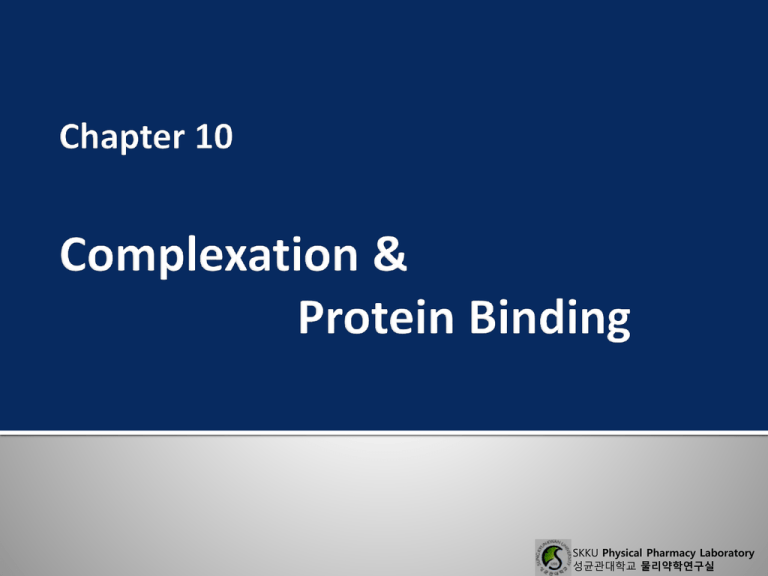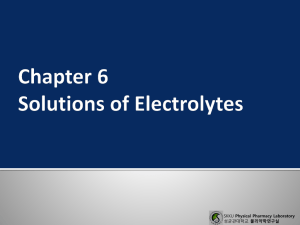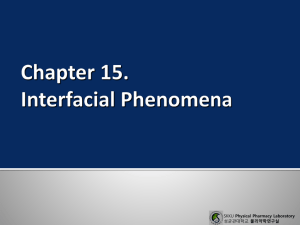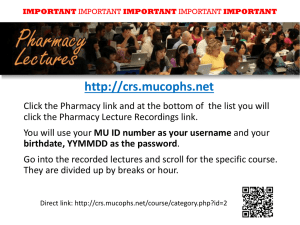
SKKU Physical Pharmacy Laboratory
성균관대학교 물리약학연구실
SKKU Physical Pharmacy Laboratory
성균관대학교 물리약학연구실
SKKU Physical Pharmacy Laboratory
성균관대학교 물리약학연구실
SKKU Physical Pharmacy Laboratory
성균관대학교 물리약학연구실
SKKU Physical Pharmacy Laboratory
성균관대학교 물리약학연구실
SKKU Physical Pharmacy Laboratory
성균관대학교 물리약학연구실
SKKU Physical Pharmacy Laboratory
성균관대학교 물리약학연구실
SKKU Physical Pharmacy Laboratory
성균관대학교 물리약학연구실
SKKU Physical Pharmacy Laboratory
성균관대학교 물리약학연구실
SKKU Physical Pharmacy Laboratory
성균관대학교 물리약학연구실
Introduction
Metal-ion coordinate complexes
Organic molecular complexes
Inclusion complexes
Cyclodextrin complexes
Ion-exchange resins
SKKU Physical Pharmacy Laboratory
성균관대학교 물리약학연구실
Introduction
SKKU Physical Pharmacy Laboratory
성균관대학교 물리약학연구실
Complexation
▪
Covalent or noncovalent interactions between two or more compounds that are capable of
independent existence
Ligand
▪ Molecule that interacts with another molecule, substrate, to form a complex
Alteration of physical and chemical properties of complexing species
▪ Solubility
▪ Theophylline + ethylenediamine → aminophylline
▪ Stability
▪ Labile drug + cyclodextrin → inclusion complex
▪ Partitioning
▪ Energy absorption & emission
▪ Conductance
Optimization of delivery system
▪ Ion-exchange resins
SKKU Physical Pharmacy Laboratory
성균관대학교 물리약학연구실
Complexation of ligand with substrate
Coordinate covalent bonding
Noncovalent interactions
▪
▪
▪
▪
▪
▪
van der Waals forces
Dipolar forces
Electrostatic forces
Hydrogen bonding
Charge transfer
Hydrophobic interaction
SKKU Physical Pharmacy Laboratory
성균관대학교 물리약학연구실
SKKU Physical Pharmacy Laboratory
성균관대학교 물리약학연구실
Metal-ion coordinate complexes
SKKU Physical Pharmacy Laboratory
성균관대학교 물리약학연구실
Coordination complex (compound)
Complex ion (Transition metal ion)
Ligands
Counterions
Lewis acid-base reaction
Ag+ + 2(:NH3) → [Ag(NH3)2]+
▪ Ligand (base) : NH3
▪ Metal ion (acid) : Ag+
▪ Coordinate complex : [Ag(NH3)2]+
▪ Counterion : Cl▪ Neutral complex : [Ag(NH3)2]Cl
SKKU Physical Pharmacy Laboratory
성균관대학교 물리약학연구실
Coordination number
Maximum number of atoms (groups) that can combine in the coordination
sphere with central metal atom
K3[Fe(CN)6]
▪
▪
▪
▪
▪
▪
Coordination number : 6
Ligand (base) : CNMetal ion (acid) : Fe3+
Coordinate complex : [Fe(CN)6]3Counterion : K+
Neutral complex : K3[Fe(CN)6]
SKKU Physical Pharmacy Laboratory
성균관대학교 물리약학연구실
Unidentate ligand
Single pair of electrons (basic group) bonding with metal ion
Ammonia
Bidentate
Two basic groups
Ethylenediamine
Hexadentate
Six points
EDTA (EthyleneDiamine Tetraacetic Acid)
Multidentate (polydentate)
Multiple binding sites
Polymers
Chelate
A complex that metal ion binds with two or more sites on multidentate ligand
SKKU Physical Pharmacy Laboratory
성균관대학교 물리약학연구실
SKKU Physical Pharmacy Laboratory
성균관대학교 물리약학연구실
Heme proteins
Myoglobin & Hemoglobin
▪ Transport of oxygen in blood and tissues
Cytochrome c
▪ Photosynthetic and respiratory system
SKKU Physical Pharmacy Laboratory
성균관대학교 물리약학연구실
Myoglobin
Monomeric heme protein in muscle
Intracellular storage site for oxygen
Oxymyoglobin → deoxymyoglobin
▪ Release its bound oxygen for metabolic purpose
Fe2+ (ferrous oxidation state) ⇔ Fe3+ (ferric oxidation state)
Contain one heme group inserted into a hydrophobic cleft in protein
SKKU Physical Pharmacy Laboratory
성균관대학교 물리약학연구실
Hemoglobin
Tetrameric heme protein [α(2):β(2)] in erythrocytes (red blood cells)
Bind oxygen in lungs and transport bound oxygen throughout body
Oxygen binds to an iron atom of deoxyhemoglobin
→ pull iron atom into plane of heme
→ conformational change
→ new set of binding interactions between adjacent subunits
CO (carbon monoxide)
▪ Bind to heme iron protein 200 times stronger than oxygen
→ asphyxiation by carbon dioxide poisoning
SKKU Physical Pharmacy Laboratory
성균관대학교 물리약학연구실
Deferoxamine
Chelating agent
Treat acute iron overdose
Chelation of Fe3+ (ferric iron)
→ strong coordinated water-soluble ferrioxamine complex
→ excrete through kidney
Low affinity for divalent ions (Fe2+, Ca2+)
100-mg dose of deferoxamine can bind with 8.5 mg of Fe3+ ion
SKKU Physical Pharmacy Laboratory
성균관대학교 물리약학연구실
Platinum (II) complexes
Cisplatin & Carboplatin
Treat cancer (ovarian & lung cancer)
Toxicity
▪ Cisplatin > Carboplatin
▪ Bidentate dicarboxylate ligand in carboplatin slows degradation of carboplatin into
potentially damaging derivatives
▪ Half life : carboplatin - 30 h
cisplatin - 1.5 ~ 3.6 h
Ring size of ligand increase → more effective at killing cancer cell
SKKU Physical Pharmacy Laboratory
성균관대학교 물리약학연구실
Copper ion
Proteins & enzymes
▪ Hemocyanin
▪ Superoxide dismutase
▪ Cytochrome oxidase
Cu (I) : colorless tetrahedral complexes
Cu (II) : blue
When bound oxygen, transition to Cu (II)
Cobalt ion
Vitamin B12 (cyanocobalamin)
Center of conjugated corrin ring structure
Co (II) and Co (III)
SKKU Physical Pharmacy Laboratory
성균관대학교 물리약학연구실
Zinc
Crystalline insulin
▪ Insulin hexamer can bind up to 9 atoms of zinc
Zinc finger (loop)
▪ Zn2+ binds tetrahydrally with
2 histidine and 2 cysteine residues of protein
Carboxypeptidase
Carbonic anhydrase
SKKU Physical Pharmacy Laboratory
성균관대학교 물리약학연구실
Chelating agents
▪ Treat toxicity of lead and mercury poisoning incidences
Dicalcium salt of EDTA
2,3-dimercaptopropanol (BAL)
EDTA
SKKU Physical Pharmacy Laboratory
성균관대학교 물리약학연구실
Organic molecular complexes
SKKU Physical Pharmacy Laboratory
성균관대학교 물리약학연구실
Noncovalent interactions between ligand and substrate
Oppositely charged ions (electrostatic forces)
van der Waals forces
Charge transfer
Hydrogen bonding
Hydrophobic effects
Small molecule & small molecule
Ehtylenediamine + theophylline → aminophylline
Small molecule & large molecule
Iodine + PVP → Povidone
Ion pairs
Ion-exchange resins
Self-association to form aggregates
Surfactant micelles\
SKKU Physical Pharmacy Laboratory
성균관대학교 물리약학연구실
Drug complexes
Caffeine interacts with several drugs (e.g., benzocaine)
→ alteration of physicochemical properties
(solubility, dissolution rate, etc)
Polymer complexes
Incompatibilities of certain polymers (Carbowaxes, Pluronics, and Tweens)
with tannic acid, salicylic acid, and phenol is due to formation of complexes
SKKU Physical Pharmacy Laboratory
성균관대학교 물리약학연구실
Inclusion complexes
SKKU Physical Pharmacy Laboratory
성균관대학교 물리약학연구실
Inclusion (occlusion) complexes
Compounds resulting more from architecture of molecules than from chemical affinity
Channel lattice type
Layer type
Clathrates
Monomolecular inclusion compounds: Cyclodextrins
Molecular sieves
SKKU Physical Pharmacy Laboratory
성균관대학교 물리약학연구실
Choleic acid
Urea
Deoxycholic acid is arranged to form a channel
into which the complexing molecule can fit
Crystallize in a channel-like structure
permitting enclosure of
unbranched parrafins, alcohols,
ketones, organic acids, and others
Thiourea
SKKU Physical Pharmacy Laboratory
성균관대학교 물리약학연구실
Bentonite
Clay
Montmorillonite
Trap hydrocarbons, alcohols, and glycols between the layers of their lattices
Graphite
SKKU Physical Pharmacy Laboratory
성균관대학교 물리약학연구실
Coordinating compound is entrapped in the form of a cage-like lattice
Molecular size of encaged components is important
Hydroquinone (quinol)
Cage-like hydrogen-bonded structure
4.2 Å hole
Entrap one small moelcule to every two quinol molecules
Molecules like MeOH, CO2, HCl can be trapped
but smaller molecules (H2) and larger molecules (EtOH)
cannot be accommodated
Warfarin sodium
SKKU Physical Pharmacy Laboratory
성균관대학교 물리약학연구실
Monomolecular inclusion compounds:
Cyclodextrins
SKKU Physical Pharmacy Laboratory
성균관대학교 물리약학연구실
Cyclodextrin
Isolated 1891, Villiers
Characterized 1904, Schardinger
Donut-shaped molecules of D-glucopyranose
No. Of
Glucose
residues
Molecular
weight
Internal
cavity
dimension, Å
Melting
point, ℃
Aqueous
solubility,
g/100 mL
Alpha (α)
6
973
5
275
15
Beta (β)
7
1135
6
280
1.9
Gamma (γ)
8
1297
8
275
23
Cyclodextrin
type
SKKU Physical Pharmacy Laboratory
성균관대학교 물리약학연구실
Cyclodextrin
No toxicity
▪ 1.6 g/kg in rats
Low aqueous solubility of β-cyclodextrin
▪ 1.9 g/100 mL
Synthesize substituted form
▪ Methyl-, dimethyl-, 2-hydroxypropyl→ aqueous solubility excess of 60 g/100 mL
Nonpolar nature of cavity
Hydrophilic nature of surface
▪ Multiple hydroxyl (-OH) functional groups
▪ Hydrogen bonding
⇒ increase aqueous solubility of hydrophobic compounds
SKKU Physical Pharmacy Laboratory
성균관대학교 물리약학연구실
Applications of cyclodextrin
Food preparation
▪ Stabilize flavors
▪ Eliminate unpleasant tastes and odors
Cosmetics & dentifrices
▪ Preparation of long-acting deodrants and emulsion bases
Pesticides
▪ Decrease in volatility and decomposition
⇒ easier application and decrease negative environmental consequences
Analytic chemistry
▪ Enhance signal
SKKU Physical Pharmacy Laboratory
성균관대학교 물리약학연구실
Pharmaceutical applications
Conversion of liquid products into powders
Decreased toxicity of drug in GI tract
▪ Aspirin + cyclodextrin
Decreased volatility
Enhancement of aqueous solubility, absorption, and bioavailability
Improved stability
Masking of unpleasant taste and odors
Prevention of incompatibilities
SKKU Physical Pharmacy Laboratory
성균관대학교 물리약학연구실
Ion exchange resins
SKKU Physical Pharmacy Laboratory
성균관대학교 물리약학연구실
Ion exchange
▪ Electrostatic interactions between bound ions on a solid particle (resin)
and oppositely charged ions in solution
Organic (polymer)
▪ Polystyrene (cross-linked with divinylbenzene)
Inorganic (mineral)
▪ Zeolites (natural, aluminum silicate chemistry)
Cation exchangers
▪ Replace (+) ion on surface with similarly charged ion
Anion exchangers
▪ Replace (-) ion on surface with similarly charged ion
Purification, drug delivery
SKKU Physical Pharmacy Laboratory
성균관대학교 물리약학연구실
Ion-exchange chromatography (separation)
Chemicals are removed selectively from solution by passing through solid resin
bed (stationary phase)
Hardness of water
Ca2+, Mg2+ ion
Zeolite (Permutite) replace undesirable ions to Na+ ion
▪ Saturated with metal ion → wash with Na+ solution
Amberlite ion exchange and XAD adsorbent resins
SKKU Physical Pharmacy Laboratory
성균관대학교 물리약학연구실
Drug delivery
Continuous exposure of resin to drug
→ drug-resin complex → releases free drug
SKKU Physical Pharmacy Laboratory
성균관대학교 물리약학연구실
Cross-linked poly(styrene sulfonate) resins
Amphetamine (Biphetamine capsules)
Phentermine (Ionamin)
Codeine, morphine (hydrocodone, chloropherinamine in Tussionex)
Delsym (Penn kinetic system)
Dextromethorphan-resin complex
Coated with ethylcellulose
12 h of release
SKKU Physical Pharmacy Laboratory
성균관대학교 물리약학연구실
Therapeutic action
Kayexalate (+)
▪ Sodium polystyrene sulfonate in 70% sorbitol suspension
▪ Treat hyperkalemia
Renagel (-)
▪ Cross-linked alylamine HCL
▪ Treat hyperphosphatemia
Cholestyramine & Colestipol (+)
▪ Cross-linked polystyrene
▪ Bind with bile acid → decrease cholesterol
SKKU Physical Pharmacy Laboratory
성균관대학교 물리약학연구실
(1) <Applied Physical Pharmacy 6th > Mansoor M. Amiji and Beverly J. Sandmann
(2) <Martin’s Physical Pharmacy and Pharmaceutical Sciences 5, 6th> Patrick J. Sinko
(3) <Physicochemical Principles of Pharmacy 4th > Alexander T. Florence and David
Attwood
(4) <Fast Track – Physical Pharmacy> David Attwood and Alexander T. Florence
SKKU Physical Pharmacy Laboratory
성균관대학교 물리약학연구실









